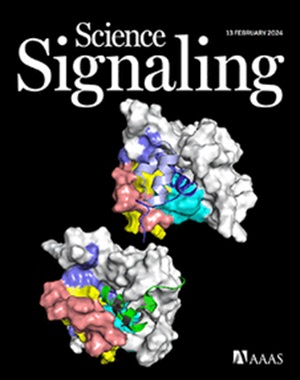A sequencing-based screening method identifies regulators of EGFR signaling from nonviable mutants in Caenorhabditis elegans
IF 6.7
1区 生物学
Q1 BIOCHEMISTRY & MOLECULAR BIOLOGY
Science Signaling
Pub Date : 2025-02-25
引用次数: 0
Abstract
Suppressor screens can identify genetic modifiers of biochemical pathways but generally require that the suppressed mutant be viable and fertile. We developed a screening method that obviated this requirement and enabled the identification of mutations that partially suppressed the early developmental arrest and lethality caused by loss of the epidermal growth factor (EGF) receptor ortholog LET-23 in Caenorhabditis elegans. We chemically mutagenized animals carrying the loss-of-function allele let-23(sy15), recovered let-23(sy15) homozygotes that escaped early developmental arrest but were nevertheless inviable, and sequenced their genomes. Testing of candidate causal mutations identified 11 genes that, when mutated, mitigated the early lethality caused by loss of EGF signaling. These included genes encoding homologs of the small guanosine triphosphatase (GTPase) Ras (let-60), which is a downstream effector of LET-23, and of regulators of the small GTPase Rho, including the homolog of the phosphotyrosine-binding protein TENSIN (tns-1). We also recovered suppressing mutations in genes encoding nuclear proteins that protect against DNA damage, including the homolog of MutS homolog 4 (him-14). Genetic experiments were consistent with the repression of Rho activity or the activation of the DNA damage response compensating for the loss of EGF signaling. This sequencing-based, whole-animal screening method may be adapted to other organisms to enable the identification of mutations for which the phenotype does not allow the recovery of viable animals.
求助全文
约1分钟内获得全文
求助全文
来源期刊

Science Signaling
BIOCHEMISTRY & MOLECULAR BIOLOGY-CELL BIOLOGY
CiteScore
9.50
自引率
0.00%
发文量
148
审稿时长
3-8 weeks
期刊介绍:
"Science Signaling" is a reputable, peer-reviewed journal dedicated to the exploration of cell communication mechanisms, offering a comprehensive view of the intricate processes that govern cellular regulation. This journal, published weekly online by the American Association for the Advancement of Science (AAAS), is a go-to resource for the latest research in cell signaling and its various facets.
The journal's scope encompasses a broad range of topics, including the study of signaling networks, synthetic biology, systems biology, and the application of these findings in drug discovery. It also delves into the computational and modeling aspects of regulatory pathways, providing insights into how cells communicate and respond to their environment.
In addition to publishing full-length articles that report on groundbreaking research, "Science Signaling" also features reviews that synthesize current knowledge in the field, focus articles that highlight specific areas of interest, and editor-written highlights that draw attention to particularly significant studies. This mix of content ensures that the journal serves as a valuable resource for both researchers and professionals looking to stay abreast of the latest advancements in cell communication science.
 求助内容:
求助内容: 应助结果提醒方式:
应助结果提醒方式:


